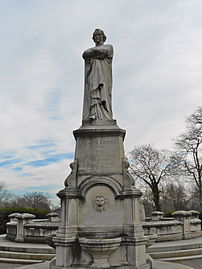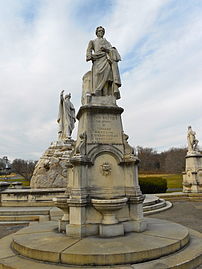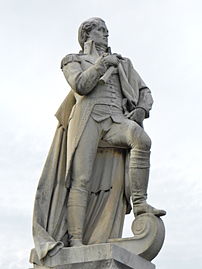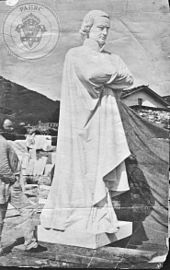Catholic Total Abstinence Union Fountain
| Catholic Total Abstinence Union Fountain | |
|---|---|
 | |
| Artist | Herman Kirn, designer and sculptor Thomas McElwee, portrait medallions[1] Isaac H. Hobbs & Son, architects |
| Year | 1874-1877 |
| Type | Fountain and water fountain |
| Location | Avenue of the Republic & States Street, Philadelphia, Pennsylvania |
The Catholic Total Abstinence Union Fountain (1874–1877) – also known as The Catholic Total Abstinence Centennial Fountain or The Centennial Fountain – is a now-defunct ornamental fountain and drinking fountain located in West
Creation
The fountain was intended to symbolize "the power of religion, the virtues of temperance, and the Irish Catholic love of patriotism and liberty."[2]
It was designed by German-born-and-trained Philadelphia sculptor Herman Kirn (1847/48 - 1920). Kirn came to the U.S. at age six, then returned to Karlsruhe as a young adult to study under Carl Johann Steinhäuser for six years.[3] Steinhäuser provided letters of recommendation for this commission. [4] Kirn's other work in the park includes the 1883 Willian Penn statue atop Mom Rinker's Rock, titled Toleration, and his Orestes and Pylades drinking fountain of 1884, cast in bronze from a Steinhäuser original design.[5][6][7][8] During the erection of this last piece, Kirn lost the use of his right arm to a falling piece of stone. Thereafter the Park employed him.[3][9]
Kirn exhibited a 12-foot diameter
Description

The fountain's 100-foot-wide stepped base is of granite and in the shape of a
Dedication
The fountain was dedicated on July 4, 1876, following a mass at the Cathedral of Saints Peter and Paul; and a parade of more than 5,000 north on Broad Street, west on Girard Avenue, and over the Girard Avenue Bridge to the Centennial fairgrounds.[16] Composer Edward Mack wrote the "Centennial Fountain Grand March" for the occasion.[17] Speeches were made by prominent Catholic clergy and individuals, culminating in a final blessing by Father James O'Reilly:
Oh God, by whose word all things are made holy, give Thy blessing to this Fountain, and grant that whosoever will make use with thanksgiving, according to Thy will and Thy law, may, through the invocation of Thy most holy name, receive from Thee health of body and spiritual protection, through Christ our Lord, Amen.[18]

The fountain itself was operational for the dedication, including the sixteen pedestal drinking fountains, but only the statue of Commodore Barry was in place. The other four were still in Austria, and in various states of completion. It remained in this condition through the November 1876 closing of the exposition, and beyond. The Father Mathew, Archbishop Carroll, and Charles Carroll of Carrollton statues were dedicated on March 17, 1877 (Saint Patrick's Day); and the central Moses Striking the Rock of Horeb statue was dedicated on July 4, 1877.[19]
Later history
The statue of Father Mathew was damaged by lightning on June 18, 1910.[20] Sculptor Kirn, who had modeled it 35 years earlier, repaired it.[21]
Gallery
-
Moses Striking the Rock of Horeb.
-
Archbishop Carroll.
-
Charles Carroll of Carrollton.
-
Father Mathew
-
Commodore Barry.
-
Herman Kirn w. J. Carroll ca. 1875
-
Herman Kirn clay model for Moses, Catholic Total Abstinence Union Fountain.
-
Photo of Fountain w. water running.
See also
References
- ^ Gallagher, p. 4.
- ^ "The Centennial Fountain," Potter's American Monthly Magazine, vol. 6, no. 49 (January 1876), p. 70.
- ^ a b "Herman Kirn Obituary". Philadelphia Inquirer via newspapers.com (sub req'd). 20 July 1920. Retrieved 9 October 2020.
- ^ (Gasparini, p. 26)
- ^ Twenty-Seventh Annual Report of the Fairmount Park Art Association (Philadelphia: 1899), p. 8.
- ^ Orestes and Pylades Fountain from SIRIS.
- ^ Orestes and Pylades Fountain from Philadelphia Public Art.
- ISBN 9783034301381. Retrieved 9 October 2020.
- ^ (Gasparini p. 55)
- ^ Gasparini, pp. 23-24.
- ^ Gasparini, p. 27.
- ^ Gasparini, p. 40. Note: Following World War I, the Austrian region of South Tyrol became part of Italy.
- ^ Exodus 17:6 – "Behold, I will stand before thee there on the rock of Horeb; and thou shalt smite the rock, and there shall come water out of it, that the people may drink."
- ^ Gasparini, pp. 16-17. George's Hill overlooks the fountain, and is the site of the Mann Center for the Performing Arts.
- ^ Atzbach, Nicole (2016). Portraits in Conversation: Francisco de Goya and Vicente López y Portaña (lecture). Meadows Museum. Event occurs at 41m45s. Retrieved September 17, 2018.
- ^ Gasparini, p. 42.
- ^ Centennial Fountain Grand March from Library Company of Philadelphia.
- ^ Joseph Skelton Longshore & Benjamin Knowles, "The Total Abstinence Benevolent Union Demonstration," The Centennial Liberty Bell, (Philadelphia: Claxton, Remsen & Haffelfinger, 1876), pp. 176-82.
- ^ Gasparini, p. 45.
- ^ The Monumental News, August 1910, p. 573.
- ^ "H. Kirn repairing the statue of Fr. Mathew," from Philadelphia Archdiocese Historical Research Center.
39°58′56.64″N 75°13′10.56″W / 39.9824000°N 75.2196000°W
Sources
- Daniel J. Gallagher, The Catholic Centennial Fountain Illustrated: A Tribute of the Catholics of America to the Centennial of the Nation's Birth (Philadelphia: Daniel J. Gallagher, 1877).
- Daria A. Gasparini, A Celebration of Moral Force: The Catholic Total Abstinence Union of America Centennial Fountain, masters thesis, University of Pennsylvania, 2002.
External links
- Aerial Video by Serge Maslennikov from YouTube.
- Catholic Total Abstinence Union Fountain from SIRIS.
- Catholic Total Abstinence Union Fountain from Philadelphia Archdiocese Historical Research Center.
- Catholic Total Abstinence Fountain from Getty Images.








